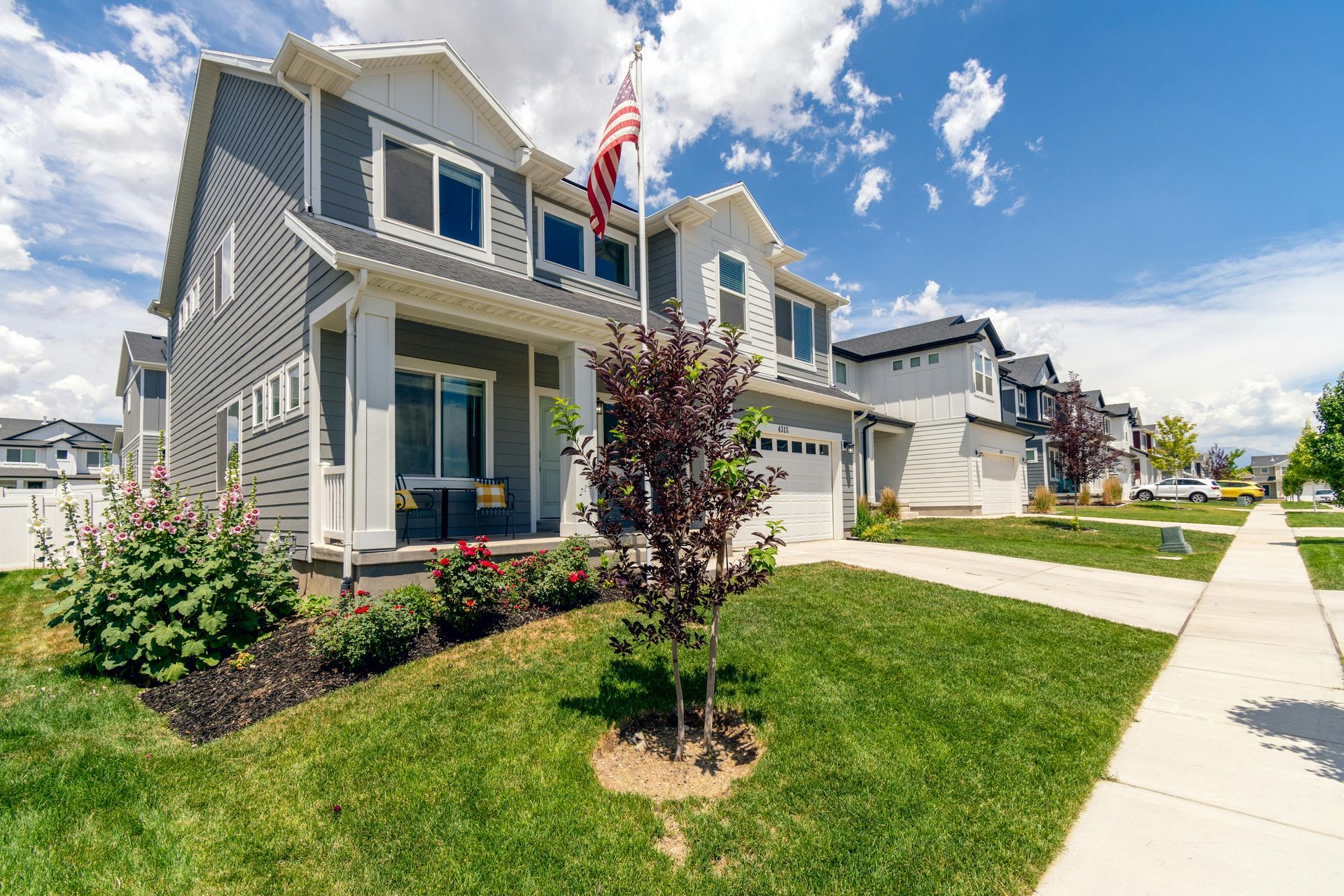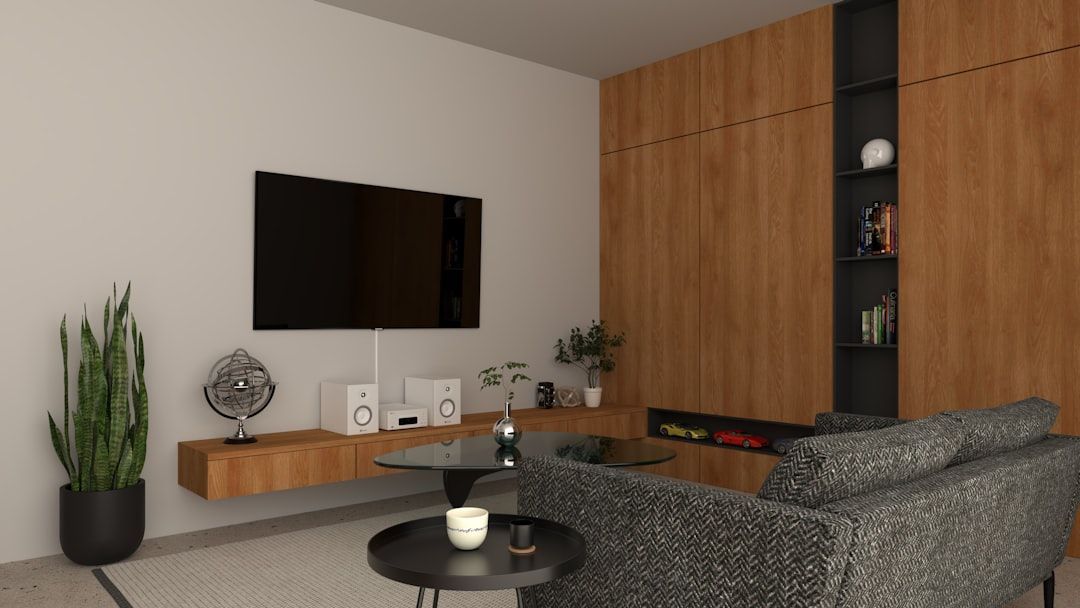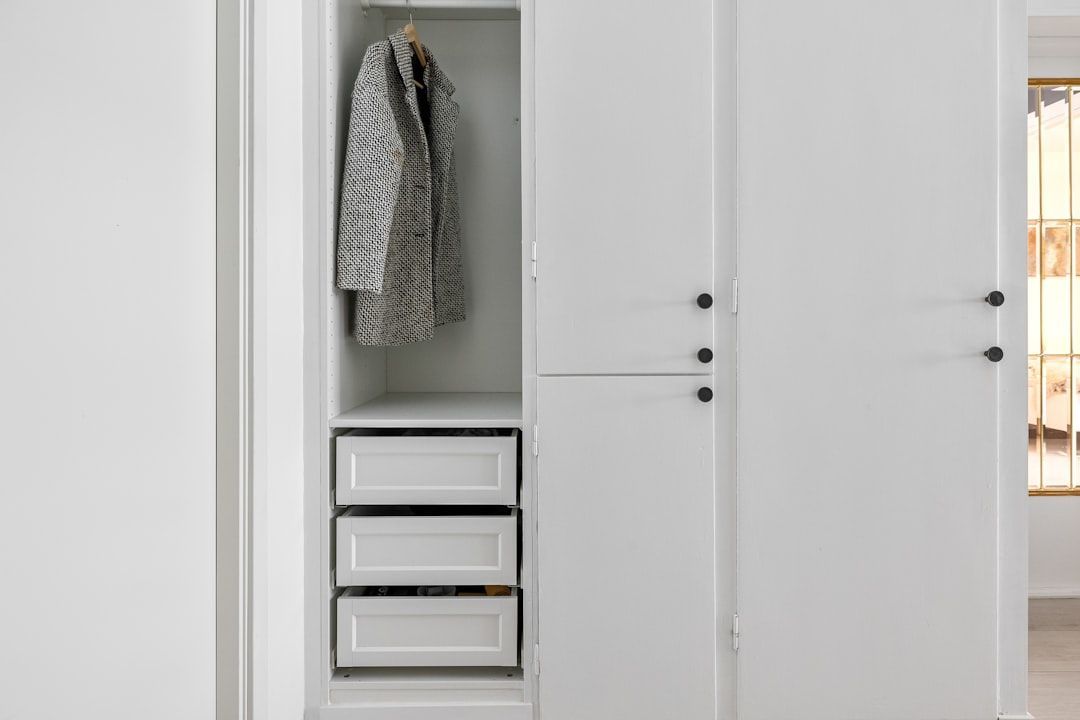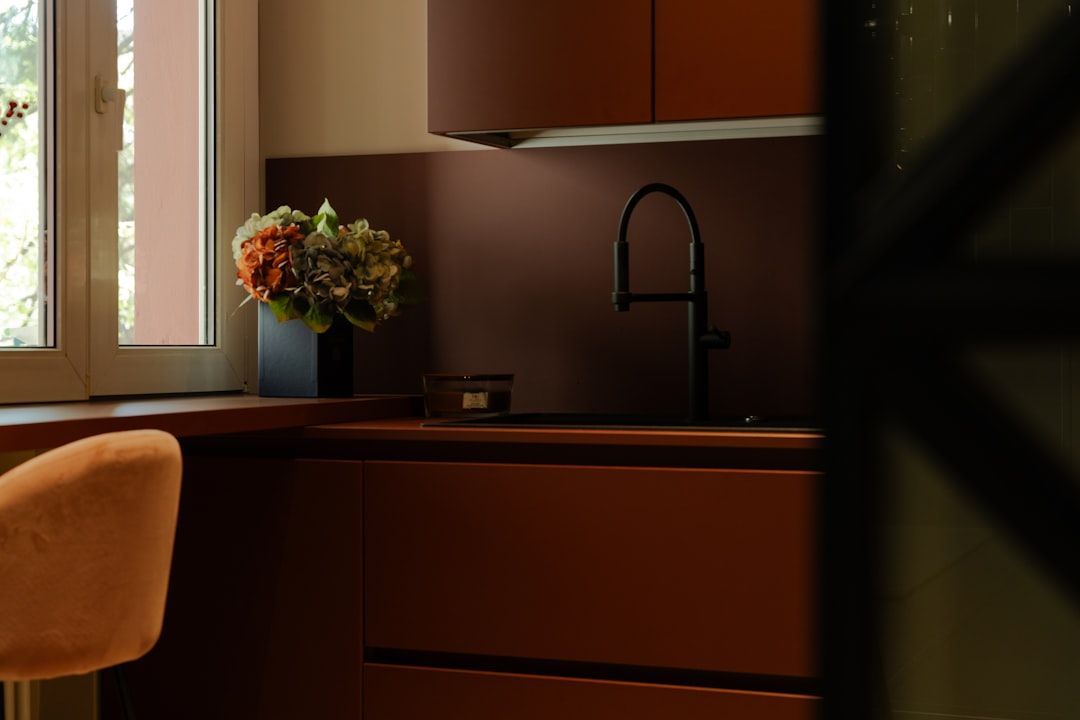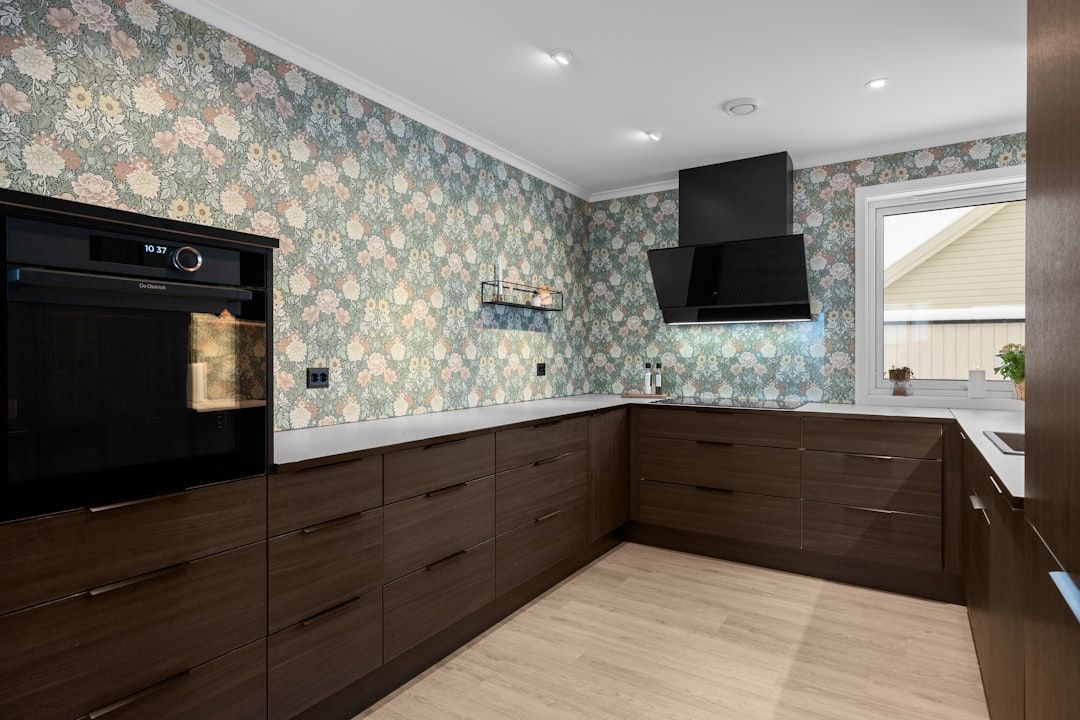Energy-Efficient Home Upgrades That Actually Pay Off
Why Energy-Efficient Home Upgrades Are Worth Your Investment
Energy-efficient home upgrades can transform your home into a comfortable, cost-saving haven while boosting its resale value. Here are the most impactful upgrades that actually pay off:
Top Energy-Efficient Upgrades by ROI:
- Air sealing and insulation- Up to 107% ROI, saves 10% on energy bills
- Heat pump installation- 4.3-7.1% resale premium, nearly 104% cost recovery
- Smart thermostats- 10-15% savings on heating/cooling costs
- Energy-efficient windows- 12% reduction in energy bills on average
- Heat pump water heaters- $350-550 annual savings for families
- Solar panels- 4%+ increase in home value
The numbers tell a compelling story. Nine out of 10 homebuyers prefer energy-efficient features over cheaper homes without them. More than half of real estate agents report that buyers actively seek sustainable upgrades.
But here's what most contractors won't tell you: 90% of American homes are under-insulated, and air leaks account for 25-40% of your heating and cooling losses. That means you're literally watching money fly out of your home every month.
The good good? Federal tax credits now cover 30% of many efficiency upgrades through 2032, with additional state and utility rebates available. When done right, these improvements pay for themselves while making your home more comfortable year-round.
I'm Mike Martinez, owner of Accountable Home Remodeling, and I've helped Denver homeowners steer energy-efficient home upgrades for years, ensuring they maximize both comfort and financial returns. My team specializes in integrating these improvements seamlessly into kitchen, bathroom, and whole-home renovations.
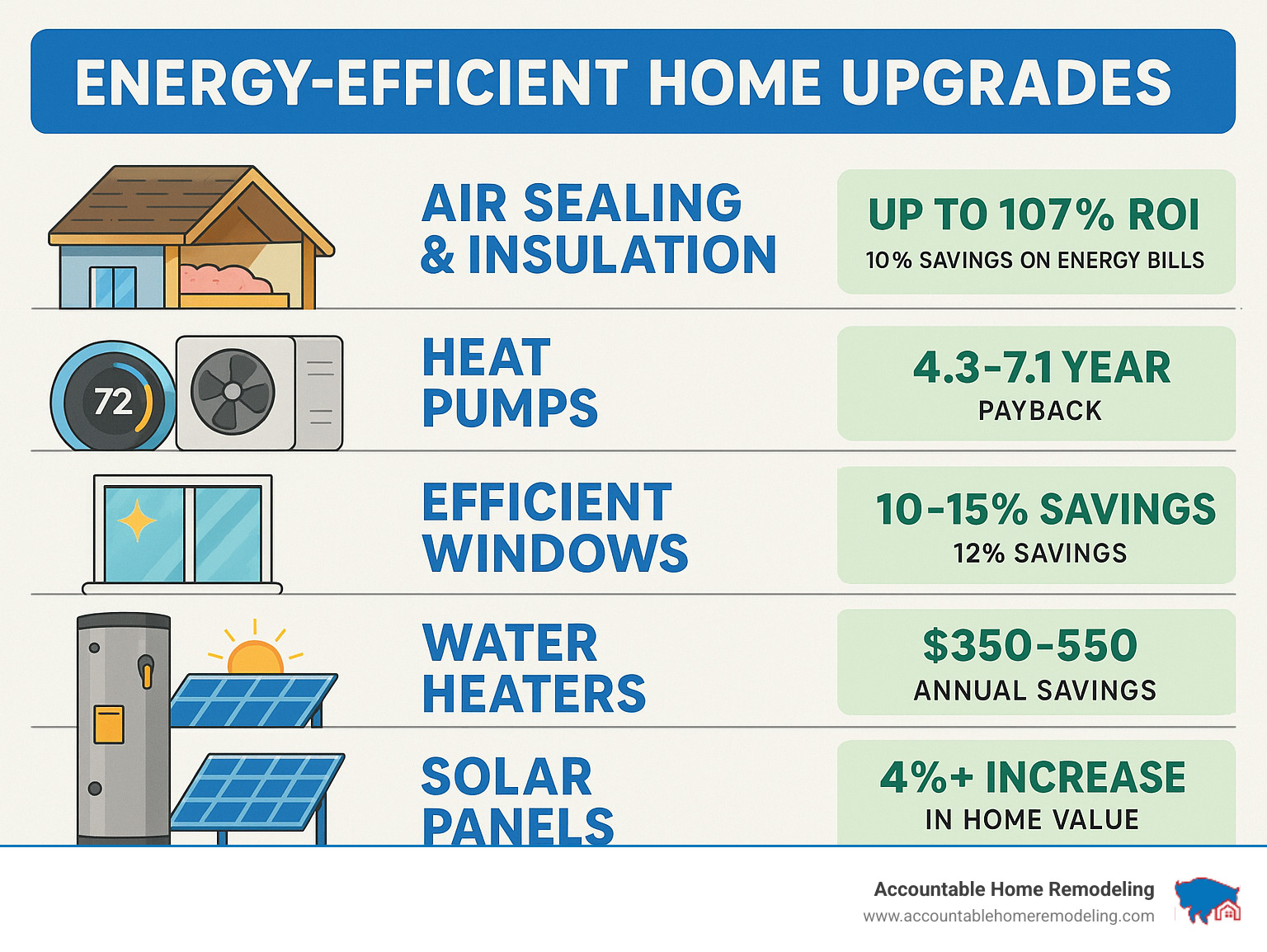
What You'll Learn
In this comprehensive guide, we'll walk you through the energy-efficient home upgrades that deliver real benefits. You'll find which improvements offer the highest return on investment, how to take advantage of federal and state incentives, and most importantly, how to avoid the common mistakes that can cost you thousands.
We'll cover everything from simple weatherization steps you can tackle yourself to major system upgrades that require professional installation. By the end, you'll have a clear roadmap for changing your home into an energy-efficient powerhouse that saves money every month.
Get to Know Your Home: The Energy Audit Roadmap
Think of a professional home energy audit as getting a complete physical for your house. Just like you wouldn't start a fitness routine without knowing your baseline health, you shouldn't begin energy-efficient home upgrades without understanding where your home is bleeding energy.
Here's the best part: energy audits now qualify for a 30% federal tax credit up to $150, making this smart investment even more affordable. When you file Form 5695 with your taxes, you'll recoup nearly a third of the audit cost while getting a roadmap that could save you thousands.
A qualified auditor brings professional-grade tools that reveal problems invisible to the naked eye. They'll use thermal imaging cameras to spot temperature differences in your walls and blower door tests to measure exactly how leaky your home is. It's like having X-ray vision for energy waste.
During the audit, your certified professional will check insulation levels in your attic, walls, and basement, then inspect your ductwork for leaks and proper insulation. They'll test your HVAC system efficiency and sizing, evaluate your windows and doors, and review your utility bills to establish your energy baseline.
The Department of Energy offers DOE tools and online calculators if you want to try a DIY assessment first. But for homes over 20 years old or if you're dealing with hot and cold spots, drafts, or sky-high utility bills, a professional audit is worth every penny.
Your audit report becomes your personalized action plan, prioritizing upgrades by cost-effectiveness and energy savings potential. This strategic approach is crucial because starting with envelope improvements like air sealing and insulation before upgrading mechanical systems can reduce the size and cost of new HVAC equipment by up to $3,700, according to the Department of Energy.
At Accountable Home Remodeling, we often coordinate with audit results when planning kitchen, bathroom, or whole-home renovations. This ensures your beautiful new spaces are also incredibly efficient, maximizing both comfort and your investment return.
Seal the Deal: Envelope Upgrades That Slash Bills
Your home's envelope - the barrier between indoor and outdoor environments - is where the biggest energy wins happen. Air sealing and insulation improvements can cut your energy use by around 10% while dramatically improving comfort.
The statistics are staggering: air leaks account for 25-40% of heating and cooling energy loss, and 90% of American homes are under-insulated. That means most homeowners are hemorrhaging money through their walls, attics, and foundations.
Air sealing comes first. Use caulk, spray foam, and weatherstripping to seal gaps around:
- Windows and doors
- Electrical outlets and switches
- Plumbing and electrical penetrations
- Attic access points
- Basement rim joists
- Fireplace dampers
After sealing air leaks, add insulation to meet recommended R-values for your climate zone. In Colorado, we typically recommend R-38 to R-60 in attics, R-13 to R-15 in walls, and R-25 to R-30 in basements.
The return on investment is exceptional. Attic insulation alone can deliver up to 107% ROI, while comprehensive air sealing and insulation projects often pay for themselves within 3-5 years through reduced utility bills.
For more guidance on sustainable materials and installation techniques, check out our Green Building Materials resource.
Choosing the Right Materials
Not all insulation materials are created equal. Here's what we recommend for different applications:
Cellulose: Made from recycled paper, cellulose offers excellent air sealing properties and works well in attics and walls. It's environmentally friendly and provides good value for the cost.
Spray Foam: The premium option for air sealing and insulation. Closed-cell spray foam provides the highest R-value per inch and creates an air barrier, but it's more expensive than other options.
Mineral Wool: Fire-resistant and moisture-tolerant, mineral wool works well in basements and areas prone to humidity. It doesn't settle over time like some materials.
Fiberglass Batts: The most common and affordable option, but only effective when properly installed without gaps or compression.
Moisture control is critical in all insulation projects. Ensure proper vapor barriers and ventilation to prevent mold and structural damage. In basements, consider exterior insulation of concrete block foundations to leverage thermal mass within the conditioned space.
Avoid These Common Mistakes
We've seen these costly errors repeatedly in our Denver projects:
Over-sealing without ventilation: Homes need controlled ventilation for indoor air quality. Don't seal so tight that you create moisture problems or poor air quality.
Missing the ducts: Duct leakage can waste up to 60% of heated air in unconditioned spaces. Always seal and insulate ductwork as part of envelope improvements.
Ignoring thermal bridging: Metal framing and other conductive materials can create thermal bridges that bypass insulation. Address these with continuous insulation or thermal breaks.
DIY disasters: While some air sealing is DIY-friendly, proper insulation installation is a science. Poor installation can reduce effectiveness by 50% or more.
Energy-Efficient Home Upgrades with Big Paybacks
Once you've sealed and insulated your home's envelope, it's time for the exciting part – the system upgrades that transform how your home uses energy. These energy-efficient home upgrades require bigger investments upfront, but they deliver impressive returns for decades to come.
Solar panels lead the pack for long-term value creation. They can increase your home's value by over 4% while potentially eliminating your electric bills entirely. With the 30% federal tax credit making solar more affordable than ever, and Colorado's net metering policies letting you sell excess power back to the grid, it's no wonder solar installations are booming in our area.
Heat pumps are quietly revolutionizing home comfort. Instead of burning fuel or using resistance heating, they simply move heat from one place to another – achieving efficiencies 2-3 times higher than traditional furnaces and air conditioners. The real estate market has noticed too, with homes featuring heat pumps commanding a 4.3-7.1% price premium when sold.
Your water heating gets the same efficiency boost with heat pump water heaters. These clever units can save a family of four about $550 annually compared to conventional electric water heaters. They work like a refrigerator in reverse, pulling heat from the air around them to warm your water.
ENERGY STAR windows might seem like a smaller upgrade, but they pack a punch. Quality windows reduce heat loss by 25-50% compared to single-pane units, typically lowering energy bills by 12%. Look for low-emissivity coatings and proper sizing for Colorado's climate extremes.
Smart thermostats represent the brain of your efficient home. They learn your family's schedule and preferences, automatically adjusting temperatures for maximum efficiency without sacrificing comfort. Most homeowners see 10-15% savings on heating and cooling costs, with the devices paying for themselves in under two years.
Don't overlook LED lighting – while each bulb saves a modest amount, lighting accounts for about 11% of home energy use. LEDs use 75% less energy than old incandescent bulbs and last 25 times longer, virtually eliminating the hassle of changing bulbs.
For detailed guidance on solar planning and installation, the Department of Energy's Installing Renewable Energy Systems resource provides comprehensive information.
Energy-efficient home upgrades for Heating & Cooling
Here's where the biggest energy wins happen. Heating and cooling devour 43% of the average home's energy, making HVAC upgrades some of the most impactful energy-efficient home upgrades you can tackle.
Heat pumps are the clear champions in this category. Air-source heat pumps work beautifully in Colorado's climate, while ground-source (geothermal) systems offer even higher efficiency if your property allows for the installation. Modern cold-climate heat pumps keep working efficiently down to -15°F, making them perfect even for our mountain communities.
Getting the sizing right is absolutely critical. An oversized system cycles on and off constantly, wasting energy and leaving you uncomfortable. An undersized system struggles to keep up on extreme days. Professional load calculations ensure your new system fits your home perfectly – and this precision can reduce equipment costs by up to $3,700 compared to oversized units.
Smart thermostats become even more valuable with heat pumps. They learn your family's patterns and manage the system for peak efficiency. Some models handle zoning systems that divide your home into separate climate zones, each with its own thermostat. This prevents heating or cooling empty rooms and can slash HVAC energy use by 20-30%.
Many Colorado utility companies offer rebates or even free smart thermostats through their energy efficiency programs – it's worth checking before you buy.
For comprehensive strategies on optimizing your home's lighting efficiency, our Energy-Efficient Lighting Solutions guide covers everything from LED selection to smart controls.
Energy-efficient home upgrades for Water & Appliances
Water heating quietly consumes nearly 20% of your home's energy, making it the second-largest energy expense after heating and cooling. Heat pump water heaters are game-changers here, operating 2-3 times more efficiently than conventional electric units and saving up to $350 per year for a typical family.
These units extract heat from the air around them to warm your water – essentially running a small heat pump dedicated to your hot water needs. They work best in basements or utility rooms where they provide the bonus benefit of dehumidifying the space.
WaterSense fixtures attack the problem from the demand side, reducing how much hot water you need without sacrificing performance. A WaterSense showerhead saves about 4 gallons per shower, while efficient faucets can save 700 gallons per year per fixture. The hot water savings add up quickly on your energy bills.
ENERGY STAR appliances have improved dramatically over the years. Today's refrigerators use about 75% less energy than 1970s models, while ENERGY STAR washing machines use 25% less energy and 33% less water than standard models. When you're replacing appliances anyway, the efficiency upgrades often pay for themselves through reduced utility bills.
Induction cooking deserves special attention if you're planning a kitchen remodel. Induction cooktops achieve about 85% efficiency compared to just 40% for gas ranges, plus they offer superior temperature control and safety features. The precise heat control makes cooking more enjoyable while using less energy.
Incentives, Financing, and Smart Planning
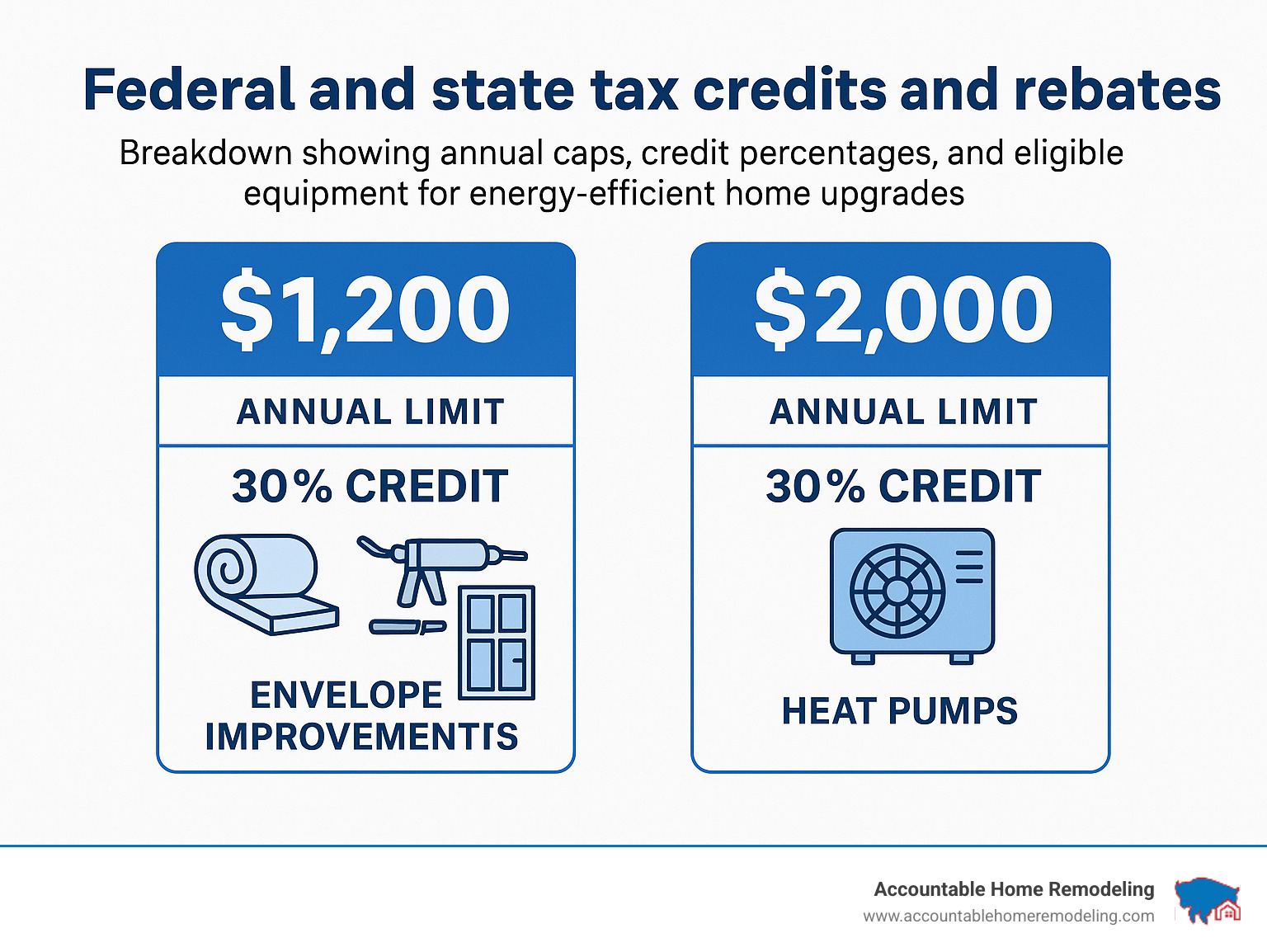
Here's the best news about energy-efficient home upgrades: Uncle Sam is practically begging you to make them. The Inflation Reduction Act created the most generous incentives we've ever seen, and they're available through 2032.
Let me break down the money that's waiting for you. The federal government offers two main tax credit programs that can dramatically reduce your upgrade costs.
The Energy Efficient Home Improvement Credit covers the bread-and-butter efficiency upgrades. You'll get 30% back on insulation, air sealing, windows, and doors up to $1,200 per year. Heat pumps, water heaters, and other qualifying equipment earn you 30% back up to $2,000 annually. Even your energy audit qualifies for a 30% credit up to $150.
The Residential Clean Energy Credit is where things get exciting for bigger projects. Solar panels, geothermal systems, and other renewable energy installations earn you 30% back with no annual caps. Install a $30,000 solar system? You'll get $9,000 back on your taxes.
But federal credits are just the beginning. Colorado utilities offer substantial rebates that stack with federal incentives. Xcel Energy, for example, provides rebates for heat pumps, efficient water heaters, and smart thermostats. These rebates come as instant discounts or checks, giving you immediate savings on top of tax credits.
The timing strategy matters more than most homeowners realize. Since envelope improvements have a $1,200 annual cap, consider spreading major projects across multiple tax years. Start with air sealing and insulation in year one, then tackle equipment upgrades in year two to maximize your $2,000 equipment credit.
Energy-efficient mortgages offer another financing path that's often overlooked. These loans let you finance efficiency upgrades as part of your home purchase or refinance. Conventional EEMs allow you to borrow up to 15% of your home's appraised value specifically for efficiency improvements, while FHA and VA programs provide additional options for qualifying buyers.
We've helped Denver homeowners steer these incentive programs for years, and the documentation requirements can be tricky. Keep detailed receipts, manufacturer certifications, and contractor invoices. For tax credits, you'll need Form 5695 and proof that equipment meets ENERGY STAR or other efficiency requirements.
The ENERGY STAR rebate finder is your best friend for finding local incentives. Utility programs change frequently, and some offer limited-time bonuses that can add hundreds to your savings.
Smart sequencing saves the most money. Start with your energy audit to identify priorities, then tackle envelope improvements first. This approach often allows you to downsize HVAC equipment, saving thousands on purchase and installation costs. At Accountable Home Remodeling, we help clients plan multi-year upgrade strategies that maximize incentives while integrating seamlessly with kitchen, bathroom, and whole-home renovations.
| Incentive Type | Coverage | Annual Limits | Best For |
|---|---|---|---|
| Federal Tax Credits | 30% of costs | $1,200 envelope, $2,000 equipment | Major upgrades |
| State Rebates | Fixed amounts | Varies | Equipment purchases |
| Utility Programs | Rebates/financing | Program-specific | Immediate savings |
| EEM Loans | Up to 15% home value | Loan limits | Comprehensive upgrades |
The payback periods are compelling when you factor in all available incentives. A $10,000 heat pump installation might cost you just $5,000 after federal credits and utility rebates, cutting the payback period in half while delivering decades of savings and comfort.
Frequently Asked Questions about Energy-Efficient Home Upgrades
How do I prioritize upgrades for my specific home?
Your energy audit results are your best friend here - they'll show you exactly where your home is bleeding energy and money. Think of it as a doctor's diagnosis for your house.
Start with your audit findings to identify the biggest energy losses first. Most homes follow a similar pattern: air leaks and poor insulation cause the most waste, so tackle those envelope improvements before anything else.
Your climate zone plays a huge role in prioritization too. Here in Colorado, our temperature swings mean heat pumps and quality insulation deliver exceptional value. Mountain homes might prioritize different upgrades than those on the Front Range.
Budget reality often drives the timeline. If you're working with limited funds, smart thermostats and LED lighting give you quick wins while you save for bigger projects. But if you're planning a major renovation anyway, that's the perfect time to bundle envelope improvements with your kitchen or bathroom remodel.
The sweet spot is addressing air sealing and insulation first, then right-sizing your HVAC equipment based on your home's improved efficiency. This sequence can actually save you thousands on equipment costs since your new heat pump or furnace can be smaller.
Which upgrades offer the highest ROI?
After helping Denver homeowners with energy-efficient home upgrades for years, I've seen which improvements truly pay off. The numbers don't lie, but the comfort improvements are just as valuable as the financial returns.
Attic insulation leads the pack with up to 107% ROI - you literally get back more than you spend when you sell your home. Air sealing delivers about 83% ROI, especially when you factor in available rebates.
Heat pump installations recover nearly 104% of their cost at resale, plus they provide year-round comfort and lower monthly bills. We've seen families save $200-400 monthly on utilities after switching from old furnaces and air conditioners.
Smart thermostats might seem small, but they typically pay for themselves within two years through energy savings alone. LEDs have a 3-5 year payback and last decades.
Here's what most people don't consider: the comfort and maintenance savings are huge but harder to calculate. No more cold spots, fewer HVAC repairs, and better indoor air quality all add real value to your daily life.
Can I combine federal credits with state or utility rebates?
Absolutely, and this is where the real savings magic happens. Stacking incentives can cover 50% or more of your upgrade costs when done strategically.
Federal tax credits typically don't get reduced by state rebates, but you need to subtract utility rebates from your qualified expenses before calculating the federal credit. It sounds complicated, but the savings are worth understanding the rules.
Documentation is everything for successful incentive stacking. Keep receipts, manufacturer certifications, installer credentials, and rebate confirmations organized. Some programs require pre-approval or specific equipment models, so do your homework before buying anything.
Many utility rebates require professional installation and certified equipment. That's actually good news because proper installation ensures you get the full efficiency benefits you're paying for.
We help our clients steer these incentive programs during their remodeling projects. When you're already upgrading your kitchen or bathroom, adding envelope improvements and efficient equipment becomes much more cost-effective with proper incentive planning.
Conclusion
Your home is more than just a place to live – it's your biggest investment and your family's sanctuary. Energy-efficient home upgrades transform both aspects, creating a more comfortable space while putting money back in your pocket every month.
The numbers speak for themselves. With federal tax credits covering 30% of costs through 2032 and upgrades like attic insulation delivering up to 107% ROI, you're not just spending money – you're investing in your family's future. Add in the dramatic improvements to comfort, indoor air quality, and home value, and the decision becomes clear.
At Accountable Home Remodeling, we've watched countless Denver Metro families find the joy of a truly efficient home. There's something magical about walking into a house that stays comfortable year-round without breaking the bank. We've helped homeowners in Broomfield, Westminster, Thornton, Northglenn, Arvada, Boulder, Denver, Longmont, Aurora, and Lakewood achieve exactly that.
What sets us apart isn't just our technical expertise – it's our commitment to transparent communication and personalized solutions. We take the time to understand your family's unique needs, budget, and timeline. Then we craft a plan that makes sense for your specific situation, whether that's integrating efficiency upgrades into a kitchen renovation or planning a whole-home change.
The beauty of energy-efficient home upgrades is that they work behind the scenes. Your family simply enjoys consistent temperatures, lower utility bills, and the peace of mind that comes with a home that takes care of itself. Meanwhile, you're building equity and preparing for a future where energy costs will only continue to rise.
The best approach starts with understanding your home's specific needs through a professional energy audit. From there, prioritize envelope improvements before upgrading systems. This strategic sequence maximizes both your immediate comfort and long-term savings.
For fresh perspectives on combining efficiency with beautiful design, explore our Green Home Renovation Ideas. You'll see how sustainability and style work hand in hand to create spaces your family will love for decades.
Ready to take the next step? Contact our team today for a consultation that will open your eyes to your home's potential. We'll walk through your space together, discuss your goals, and develop a phased approach that fits your timeline and budget.
The future of comfortable, affordable living is waiting. Let's build it together, one smart upgrade at a time.





